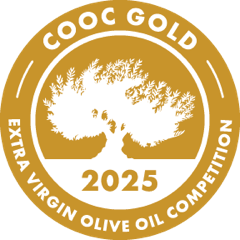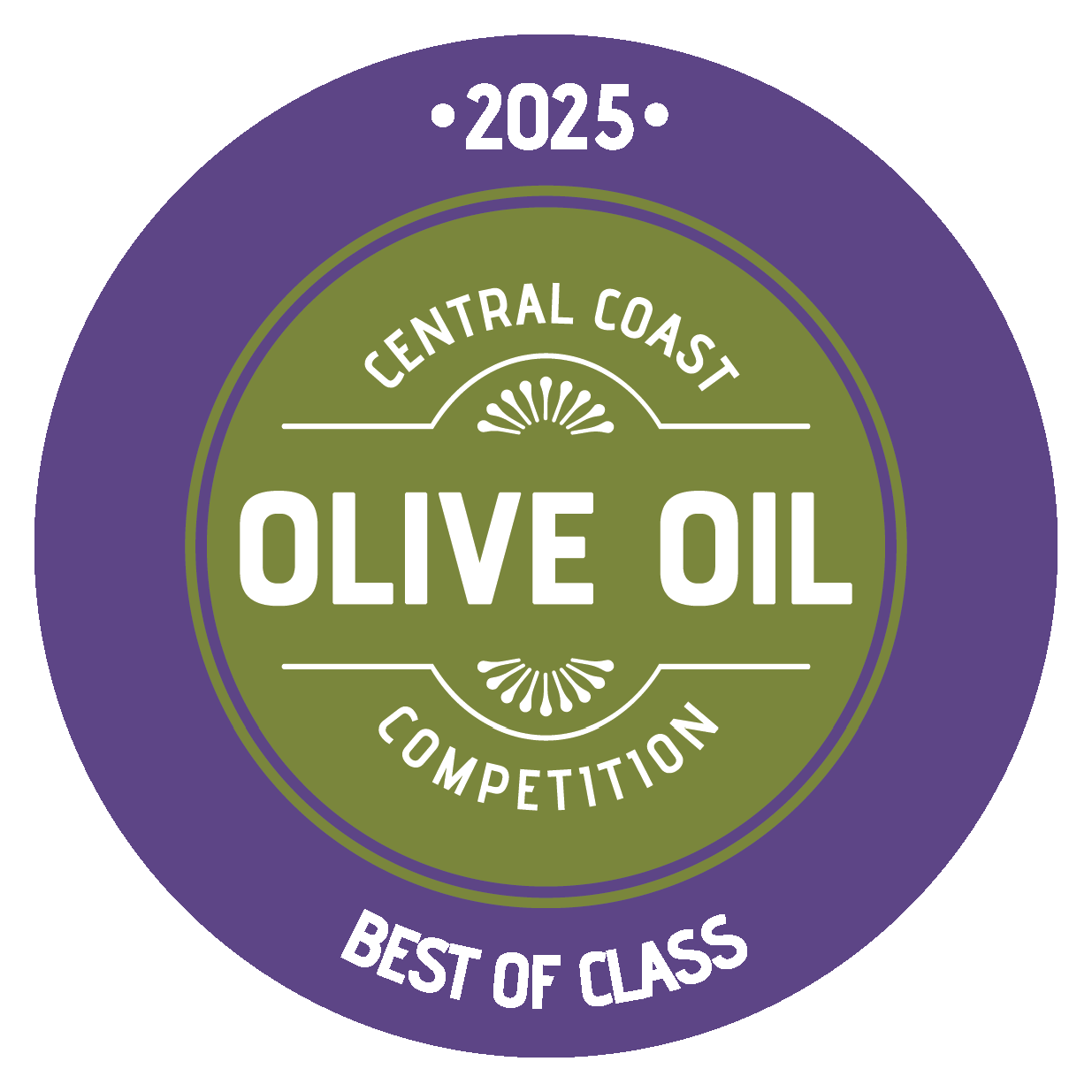
ABOUT
We love talking about what we do. We work hard to make an olive oil that is pretty special, and that supports a special cause.
2024
Balanced
Fruity
Pungent
Fresh
AWARDS
We aren’t in it for the accolades, but we’re always proud to be recognized
OUR OIL
TASTING NOTES
Balanced, fruity, pungent, fresh.
Koroneiki’s high polyphenol count give it a slight bitterness, which is what makes it so great on food and so good for you!
SERVING SUGGESTION
For best results, use at room temperature and let the warmth of the food heat the oil and enhance the aroma. It is a delicious alternative to butter, making it perfect for salad dressing, baked potatoes, bread dippin’, and our favorite, air popped popcorn as well as a great topper for grilled meats and vegetables.
WE LOVE OUR TREES
Our drought-resistant Koroneiki orchard brings a robust flavor to our olive oil. These trees are some of our hardest workers and we can’t argue with their results. The central valley has some of the best soil in the world and the southern valley has a climate similar to Greece’s southern Peloponnese olive growing region, which gives our California sun-ripened olives the polyphenol characteristics that foodies and the health-conscious seek.
OHANNESON FARMS
Ohanneson Olive Oil is grown by Ty Ohanneson, representing the fifth generation of Ohannesons farming in the San Joaquin Valley. The olive orchard is on a parcel the Ohannesons have been farming since 1952, when the land was bought from the city of Shafter and converted from desert into farmland.
Ty’s grandfather, John Ohanneson – a Shafter legend – planted 37 acres of olives in 2010 at the age of 87, the same year Ty joined the farming operation. Always looking forward, the WWII veteran was a part of the growing trend towards healthy food. Taken together with the almonds and pistachios already being grown on the ranch, this olive orchard brought the ranch to the grand total of 100% of land being devoted to healthy fruits and lower environmental impact orchards.
John continued to run the farm until he passed away in 2014 at the age of 91. Ty has been running the farm since with his foreman Ruben evolving and adapting to the inevitable ups and downs of farming.
The orchard is made up of 95% Koroneiki trees and 5% Arbequina, which make one of the boldest, pepperiest, most sought after oils on the market. Organic farming will ensure this orchard is sustainable and in high demand into the future. Single source and estate-grown, this oil honors the generations and knowledge that preceded it, offering an experience that is truly unique, truly Californian.
Ty is really excited about bringing Ohanneson Olive Oil from his farm to your kitchen and hopes you and yours will enjoy it as much as we do.
A HARVEST IN ACTION
Drone footage from an olive harvest completed on November 27, 2020 at Ohanneson Enterprises farm in the San Joaquin Valley.
Created by Advanced Drone Services:
Ken Allen
Owen Vencel
Posted by request from Ohanneson Enterprises, LLC.
OH Olive Oil Chemical Analysis
December 13, 2024 Harvest Date
Best Before 2027*
| Sample ID | Free Fatty Acids % as oleic acid | Peroxide Value meq/kg | Absorbance at 232nm | Absorbance at 270nm | Delta K 270 | Total Polyphenols mg Tyrosol/kg |
|---|---|---|---|---|---|---|
| 2024 OH Olive Oill | 0.10 | 3 | 1.23 | 0.07 | -0.003 | 235 |
| COOC Standards for Extra Virgin Olive Oil | <= 0.50 | <= 15 | <= 2.40 | <= 0.22 | <= +0.010 | |
| USDA Standards for Extra Virgin Olive Oil | < 0.80 | <20 | <= 2.50 | <= 0.22 | <= +0.010 |
* These values are from accredited lab analysis in December, 2024. Olive oil is a natural product and values may change over time. Numbers are provided for informational purposes only.
Free Fatty Acid (Acidity)
This year’s acidity result of 0.10 is our best yet and shows how impressive our harvest and milling processes are, resulting in one of the best extra virgin olive oils in not just California, but the world.
Here's What Free Fatty Acid (FFA) Tells You
Quality Indicator: Lower FFA levels typically indicate higher quality olive oil. According to the International Olive Council (IOC) standards, EVOO should have an FFA level of no more than 0.8% (measured as oleic acid).
Freshness and Handling: Low FFA levels suggest that the olives were processed promptly and correctly after harvesting, minimizing the time for enzymatic activity that increases FFA.
Oxidation and Rancidity: Higher FFA levels can be a sign of oxidation or poor storage conditions, which can lead to rancidity.
Oil Stability: Oils with lower FFA levels are generally more stable and have a longer shelf life compared to those with higher FFA levels.
Polyphenols
There is no universally agreed-upon standard for the optimal level of polyphenols in EVOO, but high-quality EVOOs typically have polyphenol levels ranging from 100 to 800 mg/kg. Oils with polyphenol content at the higher end of this range are generally considered superior in terms of health benefits and sensory quality.
Our delicate EVOO has plenty of polyphenol punch while remaining balanced and delicious on all types of food. Perfect for baking or a healthy-fat mayonnaise.
Peroxide
Here's what the peroxide value tells you:
Oxidation Level: The peroxide value indicates the initial stage of oxidation in the oil. A low peroxide value means the oil is fresh and has not undergone significant oxidation. According to the International Olive Council (IOC) standards, EVOO should have a peroxide value of no more than 20 milliequivalents of active oxygen per kilogram of oil (meq O2/kg).
Freshness: A low peroxide value suggests that the olive oil is fresh and has been well-handled during production and storage. High peroxide values indicate that the oil may be starting to go rancid.
Shelf Life: Oils with lower peroxide values generally have a longer shelf life because they are less oxidized and more stable.
Quality Control: The peroxide value is used in quality control to ensure the oil meets the required standards for EVOO. Consistently high peroxide values can indicate poor production practices or improper storage conditions.
Absorbance
Absorbance at 232 nm (K232)
Primary Oxidation Products: Absorbance at 232 nm indicates the presence of primary oxidation products, specifically conjugated dienes. These compounds form during the initial stages of oxidation, often due to the breakdown of polyunsaturated fatty acids.
Quality Indicator: A higher K232 value suggests a higher degree of primary oxidation, indicating that the oil may be less fresh or has been subjected to poor handling or storage conditions. According to the International Olive Council (IOC) standards, the K232 value for EVOO should be less than 2.50.
Absorbance at 270 nm (K270)
Secondary Oxidation Products: Absorbance at 270 nm measures secondary oxidation products, particularly conjugated trienes and certain aldehydes and ketones. These compounds form during the later stages of oxidation.
Oxidation Progression: A higher K270 value indicates that the oil has undergone more advanced oxidation, leading to the formation of these secondary compounds. According to the IOC standards, the K270 value for EVOO should be less than 0.22.
Overall Quality Assessment
Freshness and Handling: Both K232 and K270 values help assess the freshness and handling of the olive oil. Lower values indicate better quality and fresher oil, while higher values suggest oxidation and potential rancidity.
Compliance with Standards: Ensuring that both K232 and K270 values are within the IOC's acceptable limits is crucial for classifying the oil as extra virgin and maintaining its premium quality status.
Delta K
What ΔK Tells You
Adulteration Detection: ΔK is used to detect the presence of refined or adulterated oils. Pure EVOO should have a ΔK value close to zero. A significant deviation from zero suggests that the oil might be mixed with refined or other lower-quality oils.
Purity Verification: A low or near-zero ΔK value confirms the purity of the EVOO, indicating that it has not been mixed with refined oils or subjected to extensive processing that would alter its natural absorbance characteristics.
Quality Control: The ΔK value is part of the comprehensive set of tests used to certify the quality of EVOO. Along with other parameters like free fatty acid content, peroxide value, and specific absorbances at 232 nm and 270 nm, ΔK helps ensure that the oil meets the stringent standards for being labeled as extra virgin.
Standard Limits
According to the International Olive Council (IOC) standards, the ΔK value for EVOO should be less than or equal to 0.01. Values higher than this threshold may indicate potential adulteration or poor quality.


























